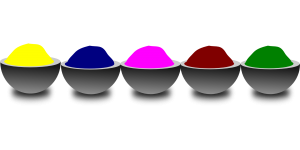 [Respected Hari-kathā Readers,
[Respected Hari-kathā Readers,
Please accept our humble obeisances. All glories to Śrī Guru and Śrī Gaurāṅga.
From 1990-1995, a group of ten to twelve ISKCON GBC sannyāsīs and other senior ISKCON members used to regularly visit Śrīla Bhaktivedānta Nārāyaṇa Gosvāmi Maharaja in his Vṛndāvana and Mathurā temples, and sometimes in his quarters at the ISKCON Juhu Beach Temple. At those times they would inquire from him about the deep meanings in various Gauḍiya Vaiṣṇava scriptures, such as Jaiva-dharma, Rāga-vartma-candrikā, the Rāsa-pañcādhyāyī chapters of Śrīmad-Bhāgavatam, and Śrī Vilāpa-kusumāñjali. There were a few hundred such meetings, and the audio sound files of many of these meetings can be found on www.purebhakti.tv.
The following is Part 1 of one of these meetings, which took place on March 29, 1993. Parts 2 and 3 will follow soon. As usual, we appreciate your feedback.
Your aspiring servants, the Hari-katha team]
‘nitya-bandha’ — kṛṣṇa haite nitya-bahirmukha
‘nitya-saṁsāra’, bhuñje narakādi duḥkha
(Śrī Caitanya-caritāmṛta, Madhya-līlā, 22.13)
Apart from the ever-liberated devotees, there are the conditioned souls, who always turn away from the service of the Lord. They are perpetually conditioned in this material world and are subjected to the material tribulations brought about by different bodily forms in hellish conditions.
Devotee: The jīva in this world – he is called eternally conditioned?
Śrīla Bhaktivedānta Nārāyaṇa Mahārāja: No, he is not an eternally conditioned soul. In this verse, nitya, ‘eternal,’ actually means anādi, or ‘beginningless,’ meaning that he has been conditioned since time immemorial. If it meant ‘eternal’ in the true sense, we would have no scope to get out of māyā.
Devotee: The anādi -baddha jīva never had any direct relationship with Kṛṣṇa?
Śrīla Bhaktivedānta Nārāyaṇa Mahārāja: It cannot be said exactly like this. Everything about his relationship with Kṛṣṇa is present in his svarūpa, but he has never felt it. In cannot be said that in a seed there is no tree, no fruit, no branches, and no leaves. All this is there, but we cannot see it; it is in a latent position.
If a person has eyes, he sees everything in the seed – how many leaves will come, how many fruits will be there, when the leaves will be green, after how much time the leaves will turn yellow, at what time they will fall, and when there will again be new leaves. Everything is there in the seed, in a latent stage.
The mukta-mahāpūruṣa, or liberated, self-realized soul, sees that the soul in this world is serving Kṛṣṇa, but we see that we are conditioned souls. No definitive mundane words can be used to actually explain jīva-tattva, because it is beyond siddhānta. In other words, the form of the soul is beyond our comprehension.
Devotee: Now the next point…
Śrīla Bhaktivedānta Nārāyaṇa Mahārāja: Do you understand this point?
Devotee: Not completely, because we can say that a seed was never a tree, even though it is latent. It is not a tree, but it will become a tree. Isn’t it the same thing with our relationship with Kṛṣṇa? You can say that the seed of our relationship is there, but it doesn’t mean there is an active relationship.
Śrīla Bhaktivedānta Nārāyaṇa Mahārāja: It is not that everything can be compared in every respect, so there are only some similarities in this analogy. Not everything is similar. For example, the seed of a tree is not cetana (conscious, or alive), but atma, the soul, is cetana. Māyā is not present in the atma. There are no clouds in the sun; but they are outside of the sun. We see the clouds, but those who are above the clouds are always seeing the sun; they do not see clouds. Similarly, self-realized souls like Śrī Nārada Ṛṣi can see that we are always serving, even though we are conditioned souls.
What we tell at this stage is only for some time. It is only an example for you at this time. It is not an exact example. You should try to perform harināma, and beg for mercy so that you will come out of māyā and realize all of these truths. Harināma is pure:
nāma-cintāmaṇiḥ
kṛṣṇaś caitanya-rasa-vigrahaḥ
pūrṇaḥ śuddho nitya-mukto
’bhinnatvān nāma-nāminoḥ
(Padma Purāṇa)
The holy name of Kṛṣṇa is transcendentally blissful. It bestows all spiritual benedictions, for it is Kṛṣṇa Himself, the reservoir of all pleasure. Kṛṣṇa’s name is complete, and it is the form of all transcendental mellows. It is not a material name under any condition, and it is no less powerful than Kṛṣṇa Himself. Since Kṛṣṇa’s name is not contaminated by the material qualities, there is no question of its being involved with māyā. Kṛṣṇa’s name is always liberated and spiritual; it is never conditioned by the laws of material nature. This is because the name of Kṛṣṇa and Kṛṣṇa Himself are identical.
Who can realize this? A devotee who has come to the stage of nirdhūta-kaṣāya or bhagavat-pārṣada-deha-prāpta* realizes that there is actually no māyā; but for a baddha-jīva, a conditioned soul, there is no conception of mukta, liberation. Those who have the bodies of Kṛṣṇa’s associates can realize this. Conditioned souls can only suppose what reality is like.
Śrīla Bhaktivinoda Ṭhākura has written in his Jaiva-dharma that devotees who perform harinama and beg mercy from Śrī Kṛṣṇa and Śrī Caitanya Mahāprabhu may realize transcendence (cetana-vastu, cid-vastu) [ Kṛṣṇa is the complete cid-vastu, or living being, and the jīva is the infinitesimal cid-vastu, or spirit spark], otherwise it is not possible.
In śāstra, numerous siddhāntas (philosophical conclusions) have been told, only for us. It is not that all siddhānta is for all persons at all stages of their development in bhakti. There is some siddhānta for kaniṣṭha Vaiṣṇavas (neophytes in bhakti), some for madhyama Vaiṣṇavas (those devotees in the intermediate stage), and some for uttama Vaiṣṇavas, those devotees who have crossed over māyā. It is not that all siddhānta is in the same category. In Śrīmad Bhāgavatam, so many categories of siddhānta are given for various classes of persons. We should therefore try to do bhajana and realize all these transcendental or spiritual truths ((cinmaya-tattva). Mundane logic and reasoning will not go there at all.
Chant, “Hare Kṛṣṇa Hare Kṛṣṇa Kṛṣṇa Kṛṣṇa Hare Hare, Hare Rāma Hare Rāma Rāma Rāma Hare Hare,” and beg pardon. Perhaps what you previously thought about the jīva and bhakti has changed. Perhaps you are now thinking, understanding, and realizing differently. Similarly, your present understanding will also change when you will become a mahā-bhāgavata and cross over māyā. Then you will realize everything.
An important point to note: the idea that the anādi-baddha jīva, the conditioned soul in this world, has fallen from the spiritual abode of the Lord is not accepted by our ācāryas.
What is your question?
Devotee: When Śrīla Jīva Jīva Gosvāmī says that by association one gets bhakti, or by mercy one gets bhakti…
Śrīla Bhaktivedānta Nārāyaṇa Mahārāja: By the association of what kind of devotee? A kaniṣṭha-vaiṣṇava? A madhyama-vaiṣṇava?
A madhyama-adhikārī Vaiṣṇava can only give siddhānta. He cannot speak from experience. If we want realization, it is necessary to hear from the three kinds of uttama-bhāgavatas: nirdhūta-kaṣāya, mūrcchita-kaṣāya and bhagavat-pārṣada-deha-prāpta. The most elevated of the three is bhagavat-pārṣada-deha-prāpta. Second, nirdhūta-kaṣāya, like Śrīla Śukadeva Gosvāmī, and third, mūrcchita-kaṣāya, like Śrī Nārada Muni. When Nārada Muni was a practicing devotee he was a mūrcchita-kaṣāya. Then, after having received darśana of the Lord, traveling here and there and always chanting the saṅkīrtana of Kṛṣṇa’s holy names, he became a first class uttama-bhāgavata; he attained the body of an associate of the Lord. Anyone can have bhakti by the association of these three mahā-bhāgavatas. The association of a madhyama-adhikari can take us to the entrance of sadhana-bhakti, and his mercy can lead us to an uttama-bhāgavata.
*Siddha-mahāpuruṣas who pursue the path of bhakti are of three types: (1) bhagavat-pārṣada-deha-prāpta (those who have obtained perfected spiritual bodies as eternal associates of the Lord), (2) nirdhūta-kaṣāya (those who have thrown off all material impurities) and (3) mūrcchita-kaṣāya (those in whom a trace of material contamination still lies dormant).
(1) Bhagavat-pārṣada-deha-prāpta ~ those who have attained perfected bodies as eternal associates of the Lord
After giving up the gross material body, those who have perfected themselves through the practise of bhakti obtain eternal, all cognizant, blissful (sac-cid-ānanda) spiritual forms, which are just suitable for the service of the Lord as associates (pārṣadas). Such persons are the best of all uttama-bhāgavatas.
(2) Nirdhūta-kaṣāya ~ those who have thrown off all material impurities
Those who, although still residing within the gross material body made of five elements, have no trace of material desire (vāsanā) nor any material impressions (saṁskāras) within their hearts are called nirdhūta-kaṣāya (those who have thrown off all material impurities). They belong to the intermediate class of uttamabhāgavatas.
(3) Mūrcchita-kaṣāya ~ those in whom a trace of material contamination still lies dormant
Those siddha-mahāpuruṣas pursuing the path of bhakti in whose hearts there remains a trace of desire (vāsanā) and impressions (saṁskāras) based on the material mode of goodness are known as mūrcchita-kaṣāya. Due to influence of their bhakti-yoga, these desires and impressions remain in a dormant, or unconscious, state. As soon as there is a favourable opportunity, their worshipful object, Śrī Bhagavān, somehow causes their desire to be consumed and attracts them to His lotus feet. Such elevated souls belong to the preliminary stage (kaniṣṭha) of uttama-bhāgavatas.
Devarṣi Nārada is an example of the topmost uttama-bhāgavata. Śukadeva Gosvāmī belongs to the intermediate stage of uttama-bhāgavatas (nirdhūta-kaṣāya). And Śrī Nārada in his previous birth as the son of a maidservant is an example of the preliminary stage of uttama-bhāgavatas (mūrcchita-kaṣāya). The association and mercy of these three kinds of mahā-bhāgavatas is the cause of the production of śraddhā. (Śrī Bhakti-rasāmṛta-sindhu-bindu)
Image/Art made possible by Pixabay.com








